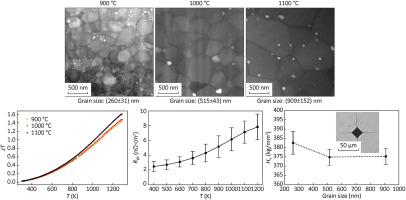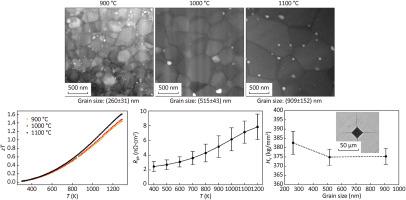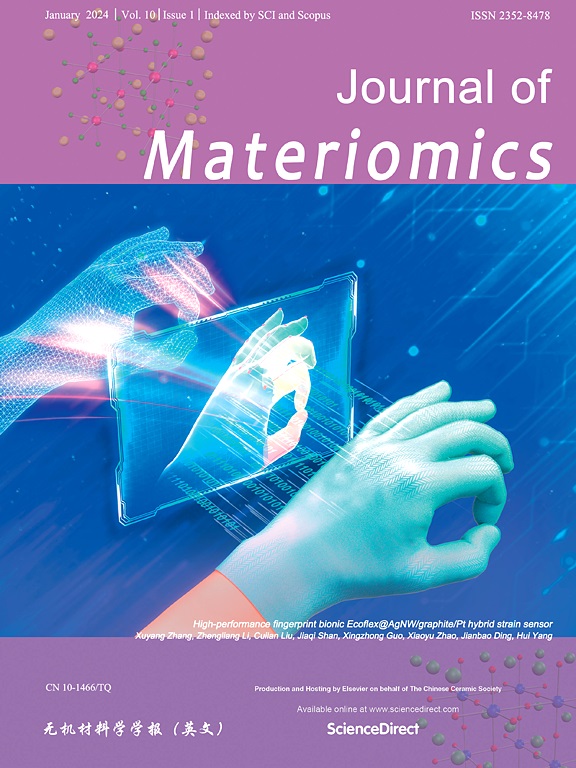Metallic grain boundary resistance in the high temperature thermoelectric La3Te4
IF 9.6
1区 材料科学
Q1 CHEMISTRY, PHYSICAL
引用次数: 0
Abstract
Electrical resistance from grain boundaries limits the thermoelectric performance of many materials. Boundary resistance is typically observed as an increase in resistivity at low temperature that decays exponentially with temperature like the resistivity of an insulator. As a result, engineering studies to mitigate boundary resistance have focused on low temperature thermoelectrics like Mg3Sb2 or improving the average zT of fine-grained, mid-temperature thermoelectrics like half-Heuslers. With less impact at high temperature, there has been little motivation to mitigate boundary resistance in high temperature materials. In this work, we demonstrate that it is necessary to consider grain boundary resistance even in high temperature thermoelectrics by improving thermoelectric performance at temperatures up to 1000 °C in La3Te4 by increasing grain size. In contrast with previous reports, this improved performance is largest at high rather than low temperatures. This is a result of a form of boundary resistance not previously reported in thermoelectric materials: uncharged or metallic boundary resistance. We observe a boundary resistance that increases linearly with temperature as expected in metals. With both this new form of boundary resistance and improved high temperature performance in La3Te4, we have demonstrated that grain boundary engineering is necessary even for high temperature applications.


高温热电la3te4的金属晶界电阻
晶界的电阻限制了许多材料的热电性能。通常观察到的边界电阻是在低温下电阻率的增加,其随温度呈指数衰减,就像绝缘体的电阻率一样。因此,减轻边界电阻的工程研究主要集中在低温热电材料(如Mg3Sb2)或提高细晶粒、中温热电材料(如半heuslers)的平均zT。由于在高温下的冲击较小,在高温材料中很少有动力减轻边界阻力。在这项工作中,我们证明了即使在高温热电材料中也有必要考虑晶界电阻,通过增加La3Te4的晶粒尺寸来改善温度高达1000°C的热电性能。与之前的报道相反,这种改进的性能在高温下最大,而不是低温下。这是一种以前未在热电材料中报道过的边界电阻形式的结果:不带电或金属边界电阻。我们观察到,在金属中,边界电阻随温度线性增加。通过这种新的边界电阻形式和La3Te4中改进的高温性能,我们已经证明了即使在高温应用中,晶界工程也是必要的。
本文章由计算机程序翻译,如有差异,请以英文原文为准。
求助全文
约1分钟内获得全文
求助全文
来源期刊

Journal of Materiomics
Materials Science-Metals and Alloys
CiteScore
14.30
自引率
6.40%
发文量
331
审稿时长
37 days
期刊介绍:
The Journal of Materiomics is a peer-reviewed open-access journal that aims to serve as a forum for the continuous dissemination of research within the field of materials science. It particularly emphasizes systematic studies on the relationships between composition, processing, structure, property, and performance of advanced materials. The journal is supported by the Chinese Ceramic Society and is indexed in SCIE and Scopus. It is commonly referred to as J Materiomics.
 求助内容:
求助内容: 应助结果提醒方式:
应助结果提醒方式:


